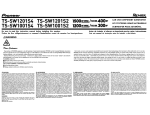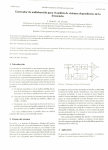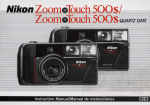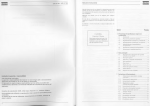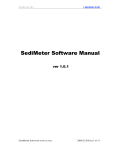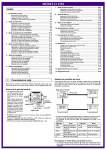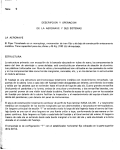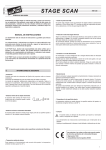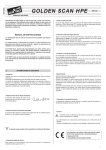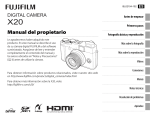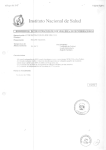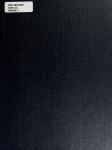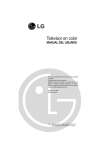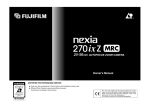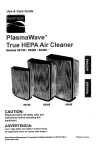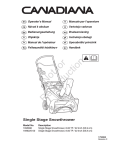Download Nuvis 75i only
Transcript
Nikon Nuvis 75
Nuvis75i
Instruction Manual (Pages 2-33)
Manual de instrucciones (Paginas 34-65)
FOREWORD
Thank you for purchasing the Nikon Nuvis 75/Nuvis 75i.
To obtain the best results from your new camera, be sure to read through this
instruction manual thoroughly.
This compact camera employs the Advanced Photo System (IX240 System) and
features:
- Simple "drop-in" film loading
- Three different print aspect ratios on the same roll of film
- Accidental double exposure prevention
- Convenient data printing (Nuvis 75i only)
2
Note: Before using your camera for an important occasion such as a wedding or
holiday, take some trial shots to fami liarize yourself with all of its features.
Nuvis 75i only: Setting the date and time (page 12)
Data recording function (page 13)
Optional remote control (page 30)
FOREWORD
I WARNING: for safe handling of the camera
Camera body
Built-in flash
• Do not disassemble or modify the camera, as it houses high -voltage circuitry
which can cause electric shocks.
• Do not touch inside metal portions of the flash if damaged, as it houses highvoltage circuitry which can cause electric shocks.
• Do not look at the sun or a strong light source directly through the viewfinder,
as it may damage your retina. Looking at the sun directly through the lens may
result in permanent eye damage.
• Do not carry the camera when mounted on a tripod, to avoid injury resu lti ng
from a fall.
• If you detect smoke around the camera, immediately stop operation and turn
OFF the camera. Let the camera cool before taking it to your local Nikon dealer.
Do not fire the flash close people 's eyes, as it may cause visual injury.
Battery
• Do not throw used batteries into the fire. Do not short circuit, disassemble or
heat the battery: this may cause it to explode resulting injury.
• Keep battery out of children's reach. If someone accidentally swallows a battery, call a doctor immediately.
Note: Nikon cannot be held responsible for malfunctions caused by using the
Nuvis 75/Nuvis 75i in ways not specified in th is manual.
3
II
CONTENTS
FOREWORD ............................................................................................................................................ 2
WARNING: for safe handling of the camera
... ................ .
. .... ............................... 3
CONTENTS .............................................................................................................................................
QUICK GUIDE .................................... ......................................................................................................
CAMERA PARTS .....................................................................................................................................
LCD PANEL ................................................................................... .........................................................
4
6
8
9
PREPARATIONS ................................................................................................................................... 10
Attaching the strap ...... .......... ............. .... .
... .. ................ .. .
.........................
Installing the battery ..... ....... .............. ...
...... .... ........ ...... ...................
Checking battery level ..... ..... ....... .....
........
Setting the date and time (Nuvis 75i only)
.. .... .... ..... .... .. ... .... .... ............... .... .... . .. ...... ...
Data recording function (Nuvis 75i only)
..... ....
Loading the film ..... ... ............ .... ......... ...... ....
........
10
10
11
12
13
14
BASIC OPERATION ................... .......................................................... .......................... ... .. .... ............... 17
Holding the camera
Shutter release button
4
..... .... 17
.. . 17
CONTENTS
Print aspect ratio ............... ................
.............. .........
~om...............................
Viewfinder ........................
........................
Focus and auto flash
.........................................
Using focus lock
Removing the fil m ....................... .............. .. ................... .... ........................
.. ..........
... .... .
.............................
............. ........
.....
.. ....... ..... ................................
18
19
20
21
23
24
ADVANCED FUNCTIONS ....................................................................... .... ............................................ 25
Red-eye reduction ............................
.........................................
........................
...... 26
Self-timer ..... .... ....................... .. ...................................... ... ........... ............. ........................................ ..................... 27
Infinity focus ...........................
..... 28
Flash-cancel ...........................
.................................
..... 28
~~~.
.
....................... •
............. ~
Slow sync flash .................................................
Optional remote control (Nuvis 75i only)
........... ... .................... .......
..... 29
...... 30
MISCELLANEOUS ..... .............. .. ........ .............. ... ............... .... .... ... .... ............ ... ................ ...... ...... ..... ..... 31
For safe handling of the camera .
Specifications. ......... .....................
. .... 31
.............. 32
5
II
QUICK GUIDE
This quick guide shows you how to take photographs right away with your new camera. Refer to the page numbers below for more details.
Open the battery chamber cover and
insert the battery as shown (page 10).
6
Turn on the power switch. The lens will
extend to the wideangle position. Confirm that the "B " disappears from the
LCD panel.
Open the cartridge chamber cover and
insert a new cartridge (page 14). The
film will automatically advance to the
first frame.
QUICK GUIDE
While looking through the viewfinder,
position the subject within the
autofocus frame marks in the center of
the viewfinder (page 21).
Press the shutter release button lightly
to focus the subject. Now depress fully
to take the picture (page 21).
The film rewinds automatically at the
end of the roll. When "E" and "I.!) " blink
on the LCD panel, remove the film cartridge (page 24).
7
CAMERA PARTS
(Nuvis 75i)
Red-eye reduction lamp/self -timer indicator lamp (page 26, 27)
Shutter release button - --
lever
(page 15)
Red LED (page 20)
CHP selector (page 18)
"'c::r-:-"i'",- Flash mode/infinity locus
button (MODEISEL
button: Nuvis 75i only)
(page 12, 13, 25)
Zoom switch (page 19)
Mid-roll rewind+-t.-button
(page 24)
--,
Viewfinder eyepiece (page 20)
-{
Red-eye reduction/
self-timer button
(ADJUST button:
Nuvis 75i only) (page
12,25)
Power switch
-
Cartridge chamber
cover (page 15,24)
Remote control unit
(Optional accessory: Nuvis 75i only)
Tripod socket
Battery chamber cover
(page 10)
Transmission button
(page 30)
~o
~
LCD PANEL
LCD PANEL
Nuvis 75
Nuvis 75i
Year ind icator
Insufficient battery
power indicator
Frame
counter!
recording
data
9
II
PREPARATIONS
I Attaching the strap
I Installing the battery
..
Slide the strap through the slot as
shown,
10
Make sure that the cartridge chamber
cover is closed when replacing batteries' Open the battery chamber cover by
pushing in the direction of the arrow, (If
necessary, insert a coin in the groove
and twist gently,)
.
~=-~------~
.
Insert a 3 V lithium battery (CR123A or
DL 123A) with the + and - poles aligned
as indicated, Close the battery chamber cover firmly so that it clicks shut.
Note:
Nuvis l5i only: Replacing the battery erases all date and time se'ttings , Remember to reset the date
and time after you replace the battery (page 12),
PREPARATIONS
I Checking battery level
Be sure to turn off the camera when not in use to conserve the battery.
OFF
00) /
\ Im....l] )
Turn the camera on .
'1r.J
AUTO ~
:~ ; Nuvis 75
' .!. #
-# I~ ,
AUTO ~
Check the LCD panel.
Nuvis 75i
If "c::lIII " blinks, the battery is low and
should be replaced as soon as possible.
If the LCD panel remains blank, the battery is exhausted or not installed correctly.
11
II
PREPARATIONS
I Setting the date and time (Nuvis 75i only)
•• MODE
DATE - SEL ADJUST
~ ~
) '1
~'~i
Set the date and time uSing the MODEl
SEL and ADJUST buttons.
1. Turn the camera off.
2. Hold down MODEISEL for two seconds until the year starts blinking.
3. Press ADJUST to set the year (hold it down to advance at high speed).
4. Press MODE/SEL again to select the month and adjust in the same way.
5. Repeat steps 3 and 4 to reset the date, hours and minutes in turn .
6. Press MODEISEL again to finish. The new date appears without blinking.
12
~~I~
J '96:=I]
~-.'
]'--.-'
' ' ' ' T, I,
_ 0-' _
1. ..1,
"J-'
:, ,
f
•
-'-1
,-'- ,
"E]
O:C~
~I-' I
-'~I~-:'L'
PREPARATIONS
I Data recording function (Nuvis 75i only)
Data is recorded on the film.
Note: When ordering prints, be sure to
ask your photo lab if they hand le
frontprinting and backprinting.
Year/month/date
Month/date/year
AUTO ~
Date/month/year
Hour/minute
-I
When the data recording function is
selected , the LCD panel displays
" ~ " whi le the camera is on.
(No recording)
~~...J
Press MODE/SEL to cycle through the
date/time formats.
13
PREPARATIONS
I Loading the film
IX240 film cartridge
Visual Exposure Indication (VEl)
Use only a fresh IX240 film cartridge.
Conventional 35 mm film cannot be
used. There is no film leader. Fi lm is
automatically thrust and loaded inside
the camera.
Data Disk
Irreversible Processed Indicator (IPI)
Cartridge Spool
"e" =
Unexposed
" . " = Partially exposed
" X " = Fu lly exposed but not pro-
cessed
". " = Processed film inside cartridge
Lightlock Door Drive
14
PREPARATIONS
o=~~=-=;~
-'Ie:.
e
Nuvis 75
Novis 75;
Turn the camera on. Confirm that the
"I!) " disappears from the LCD panel
and turn the lock-release lever to open
the cartridge chamber cover.
Note: The cartridge chamber cover
locks automatically after loading. Do
not attempt to open the cartridge chamber cover while the film is still loaded.
Insert a new cartridge as shown, and
close the cartridge chamber cover until
it clicks shut. The film will begin advancing. Film speed is set automati cally.
Note: The VEl should show". " before
loading. Do not load a film cartridge
showing ". " or ". " (The VEl automatically changes to "X ".)
The LCD panel should display "I!) " and
the frame count. (If the film is fully or
partially exposed, "I!)" and "E" will
blink on the LCD pane!.)
15
E
tI
PREPARATIONS
Processing and Printing
About IX240 film cartridge
Do not disassemble the cartridge or
subject it to shock or vibration.
Be careful not to be soil or damage the
data disk of the cartridge, as correct
data communication may be impaired.
Do not press a pointed object against
the Lightlock Door Drive. This may open
the door and expose the film.
Do not break the Irreversible Processed
Indicator (IPI) on the cartridge, as film
processing and printi ng may become
impossible. Consult with your photo lab
if IPI is broken.
16
Do not attempt to rotate the Cartridge
Spool with a pOinted object (e.g. a
screwdriver). This can expose the film,
alter the VEl, and even prevent proper
use and/or processing.
Do not store cartridges:
- In direct sunlight, near heating appliances or in other hot places
- Near dirt and dust
- In hot or humid conditions conducive
to mold
- Near strong magnetic fields
-a-
{}!ldi/ied
f-\0.I~s D.
/:Jt:!!!:L;,!;i"?
We recommend bringing your film
cartridge to a photo lab displaying the
"Authorized Photo Lab Mark" sign for
processing and printing.
Authorized Photo Labs offer these services:
--Three different (C, H or P-type) print
aspect ratios
- Data printing (Nuvis l5i only)
-Index Prints (small image of each
frame exposed on the roll of film)
- Negative Return in Cartridge (NRIC):
Your negatives are return ed inside
the cartridge for easy storage.
For further details, ask your Authorized
Photo Lab.
BASIC OPERATION
I Holding the camera
BASIC OPERATION
IShutter release button
.
~=---~----~
.
..
o
Stand with one foot slightly in front of
the other. Prop your elbows against
your body and hold the camera with
both hands as shown.
When taking vertical photographs ,
make sure that the flash is at the top
as shown.
0
Lightly press to focus the subject.
The red LED fl ickers once when the
focus is locked.
o
Fully depress to release the shutter.
Press firmly but gently to prevent camera shake. The flash will fire automatical ly if there is not enough light.
Important: Take care not to block the lens, flash or autofocus windows with
your fingers , hair or the camera strap.
17
m
~
~
BASIC OPERATION
I Print aspect ratio
Print aspect ratio can be changed at any time during the film roll.
cmp
...
;;;===~""
CHP~elector~o
Use the
tween C, Hand P-type.
choose be-
Caution: To prevent possible eye injury, hold the camera away from
your face when using the selector.
18 ·
C-type
H-type
P-type
Vertical : Horizontal = 2 : 3
Aspect ratio
Vertical: Horizontal = 9 : 16
Aspect ratio
Vertical: Horizontal = 1 : 3
Aspect ratio
BASIC OPERATION
IZoom
Wideangle (30 mm)
W (wide) increases the view for landscapes and group portraits. T (telephoto) makes distant subjects appear
closer and larger.
Telephoto (60 mm)
Note:
Nuvi s 75i : The lens retracts to the
wideangle position after about three
minutes when the camera is not in use.
Nuvis 75: After about 20 seconds, the
LCD panel goes out. (Press any button
to restore the display.) After about three
minute s, the lens retracts to the
wideangle position.
Caution: During this operation, take
care not to pinch your skin.
19
~
BASIC OPERATION
I Viewfinder
1. Parallax compensation marks-center the subject within these marks
when shooting at around 60 cm/2 ft.
2. Autofocus frame marks-'position on the subject
3. Red LED (flash ready-lightlin-focus indicator)
The viewfinder indicates the boundaries of the print aspect ratio (page 18).
The example above shows H type.
Note: Correct focus cannot be guaranteed when the subject is closer than
approx. 60 cm/2 ft.
20
BASIC OPERATION
IFocus and auto flash
Turn the camera on.
The auto flash symbol "AUTO ~ " on the
LCD panel indicates that the flash will
fire automatically if there is not enough
light. Make sure that the distance to the
subject falls within the flash shooting
range.
For ISO 200 film , the flash should be
used within the fol lowing range.
Wideangle : approx. 0.6-5.3 ill
(2-17 ft.)
Telephoto: approx. 0.6-2.8 m
(2- 9 ft.)
Position the subject within the autofocus frame marks in the center of the
viewfinder.
Lightly press the shutter release button
to focus the subject, and check the red
LED in the viewfinder.
Flickers once: Subject focused
Blinks:
Flash charging
Lights up:
Flash ready
21
a
BASIC OPERATION
Note: The minimum focusing distance
of this camera is approx. 60 cm/2 ft.
Correct focus cannot be guaranteed if
the subject is closer than approx. 60
cm/2 ft.
Now depress the shutter release button fully to release the shutter. The film
will advance automatically to the next
frame and the frame count on the LCD
panel will decrease by one.
22
..
BASIC OPERATION
I Using focus lock
When the subject does not cover the
autofocus frame marks "()", the camera focuses on the background instead.
Special focusing situations
Position the autofocus frame marks
"() " directly on the subject and lightly
press the shutter release button to focus. The red LED flickers once and the
focus is locked at this distance.
Note: Do not alter the distance from camera to subject once the focus is locked.
Keeping your finger on the shutter re lease button, recompose the orig inal
scene in the viewfinder. Now depress
fully to release the shutter.
The following subjects may be too difficult to focus:
• Subjects too small to fully cover the
autofocus frame mar.ks
• Dark subjects with no reflection
• Glossy light-reflecting surfaces, such
as shiny cars or water
• Subjects without solid content (i. e.,
candle flame, fireworks, etc.)
• Secondary subjects are closer to the
camera than the main subject.
In the above cases , use focus lock by
focusing on another subject equidistant
from the camera and follow the procedure in this section.
23
I!
BASIC OPERATION
I Removing the film
Note: If the battery fails wh ile the film
is still rewinding, replace it with a fresh
battery. Rewinding wil l resume automatically.
The film rewinds automatically at the
end of the roiL When fully rewound , "E"
and "ii} will blin k on the LCD paneL
24
Open the cartridge chamber cover with
the bottom of the came ra body positioned upward an d remove the cartridge.
To rewind the film before the end of the
roll, push the mid-rol l rewind button
once with a pen or similar object Note
that you cannot reuse film cartridge
that have been rewound in mid-roiL
ADVANCED FUNCTIONS
ADVANCED FUNCTIONS
(OFF)
Nuvis 75
!
Red~eye
Press "@ /.:'J" or "@Mi " to cycle
through the following modes:
reduction
@
Self~timer/remote control
!
(9
i
0 JNuviS75
~ /~ @/~
{ ~
Auto flash
O . lNlNis 751
lr ~~/~ @M&}
, Press ""' / f ' to cycle through the
lowi ng modes:
Infinity focus
AUTO ~
l
.6A
!
Flash~cancel
Ci)
Anytime flash
~
fol~
~
l
Slow sync flash
AUTO L
SLOW #
25
ADVANCED FUNCTIONS
I Red-eye reduction
Red -eye reduction mode helps to reduce "red-eye," a phenomenon in which the subject's pupils sometimes appear bright red in flash photographs,
r--.
@
AUTO ~
AUTO
•
~@
-' 1-
C :. Nuvis 75
e
-, .e :.
Nuvis 75i
iF)
Press the shutter release button lightly
and check that the flash is fully
charged, Now depress fully to take the
picture, Keep your finger on the button
until the shutter is released,
26
Note : The red -eye reduction lamp
lights up for approximately one second
before the flash fires , Hold the camera
still and make sure that the subject remains in position,
If you take a picture in red -eye reduction mode and then turn oft the camera, red -eye reduction mode wil l
remain in effect the next time you take
a picture,
Red-eye reduction cannot be used in
flash-cancel or infinity focus modes,
..
ADVANCED FUNCTIONS
ISelf-timer
With the camera on, press "@ / C)" or
"@/ C)&" to display "~" or "C) i"on the
LCD panel.
Note: For best results, place the cam era on a tripod or other stable surface.
Self-timer mode is automatical ly canceled after the shutter is released. To
cancel self-timer mode before taking a
picture, turn the camera off.
To start the timer, fu lly depress the
shutter release button. The indicator
lamp on the camera face will blink for 8
seconds and then light up for 2 seconds before the shutter is released.
27
tl
ADVANCED FUNCTIONS
I Infinity focus
,_=11_;
Nuvis 75
e
:":
I.: _I
~.
Nuvis 75i
iF)
lnfinity focus mode is recommended for landscape pictures or for taking photographs through a car window or glass pane.
Infinity focus mode is indicated by""", " on the LCD panel.
Note: The flash cannot be used in infinity focus mode.
28
I Flash-cancel
1
j
..
~
.
@
-.,c :.
e
CiS
Nuvis 75
Nuvis 75i
iF)
Flash-cancel mode allows you to shoot without flash in low-light situations where
the flash would normally fire. Use flash-cancel mode in art galleries and other
places where flash photography is prohibited
Flash-cancel mode is indicated by "~" on the LCD panel.
Note: Flash-cancel mode uses a slower shutter speed. For best results , use a
tripod to keep the camera steady.
ADVANCED FUNCTIONS
IAnytime flash
I t
C'~ I
Nuvls 75
~
...
~
I Slow sync flash
c
I: _. • Nuvis
...
~~J$ ~
Nuvis 75
75i
i!J
Anytime flash mode al lows you to use the flash in situations where the flash
would not normally fire, such as when the subject is standi ng in the shade or in
front of the sun.
Anytime flash mode is indicated by "~" on the LCD panel.
Slow sync flash mode combines the flash with a slower shutter speed. Use slow
sync flash mode to make the backgrou nd appear brighter and more natural in
low-light, outdoor flash photographs.
Slow sync flash mode is indicated by "~~ri~ ~ " on the LCD panel.
Note: Slow sync flash mode uses a slower shutter speed. For best results, use
a tripod to keep the camera steady.
29
a
ADVANCED FUNCTIONS
I Optional remote control (Nuvis 75i only)
..
~=---------~
r
5 m/16.4 ft .
I
AUTO
Press "@M i" to display "~i " on the
LCD panel.
30
A
(I"' ~
Point the remote control unit at the
camera and press the button. The indicator lamp will light up for about two
seconds before the shutter is released.
(Effective range = approx. 5 m/16.4 ft.
When pointed straight at camera)
Note: Remote control mode is canceled
automatically after three minutes if not
used. (To cancel remote control mode
before then, turn the camera off.)
The reception sensor on the camera is
sometimes affected by direct sunlight
or other strong light. If so, use selftimer mode instead.
For best results , place the camera on a
tripod or steady surface.
MISCELLANEOUS
MISCELLANEOUS
I For safe handling of the camera
Camera care tips
• Turn the camera OFF when not in use, to avoid accidental release of the shutter
and resulting battery drain.
• Avoid leaving the camera in excessively hot places such as the interior of a car,
a beach or near a heater.
• Allow the camera to cool off after continuous flash firing. Overuse generates
heat in battery and camera.
• The camera may not work properly at low temperatures (below O°C or 32"F).
Keep the camera warm.
·00 not drop or hit the camera against a hard surface as it may damage the
precision mechanism.
• Prevent foreign matter from getting inside the camera. Immediately wipe salt,
sand and dust from the camera with a soft, dry cloth.
• Use a blower to remove dust from the lens. If the lens is still dirty, clean it lightly
with a soft cloth.
• Never use thinner, benzene, or other active agents.
• Store the camera in a cool , dry place to prevent mold. Do not expose it to chemi cals such as camphor and naphthalene. We recommend using a desiccating
agent during storage.
• If the camera is not used for a long time , take it out regularly, release the shutter
and fire the flash a few times .
Notes on batteries
• Battery power is apt to weaken as the temperature drops below GO
C (32"F). It will
recover when taking pictures at low temperature return to normal. When taking
pictu res at low temperatures, keep the battery warm.
• Be sure to replace batteries with fresh ones or carry spare batteries when taking
important pictures.
For Canada
This digital apparatus does not exceed the (Class B) limits for radio noise emis sions from digital apparatus set out in the Rad io Interference Regulations of the
Canadian Department of Communications.
31
Ii
MISCELLANEOUS
I Specifications
Type of camera
IX240 (Advanced Photo System) type autofocus lens-shutter
camera with Nikon Zoom 30-60 mm F/4.5-8.5 lens
(37.5 mm-75 mm converted to 35 mm type)
Viewfinder
Albada-bright frame zoom viewfinder; frame coverage approx.
85% for H-type printed image area; approx. 0.37x magnification
at 30 mm , approx. 0.7x at 60 mm
Usable film
IX240 (Advanced Photo System) film cartridge (16.7 mm x 30.2
mm)
Viewfinder information
Information exchange
system
Print aspect ratio
Optical Information Exchange (Opt. IX) system (Nuvis 75)
Magnetic Information Exchange (Mag. IX) system (Nuvis 75i)
C/H/P-type image size frames with parallax compensation
marks; autofocus frame
Red LED (flash ready-lighVin -focus indicator)
flash ready
lights up:
Blinks:
flash charging
Flickers once: subject focused
Lens
30 mm F/4.5-60 mm F/8.5 (37.5 mm-75 mm converted to 35
mm type); 5 elements in 5 groups
Exposure control
Auto exposure range
Electronically controlled program AE
ISO 200: EV7 A- 15 at 30 mm EV9.3-17 at 60 mm
Film speed setting
ISO 50, 100, 200, 400, 800 and 1600 fi lm automatically set
Film operation
Drop in loading system; Double Exposure Prevention (DEP); film
automatically advances to the first frame after inserting cartridge;
film automatically advances one frame after each shot; auto rewind at the end of fi lm roll ; mid-roll rewind function
C, Hand P-type available
Lens cover
OpenS/closes automatically with power switch ON/OFF
Shutter
Programmed electronic shutter; also serves as diaphragm blades
Focusing
Infrared-active autofocus system; activated by lightly pressing
shutter release button ; range from 0.6 m (2 ft.) to infinity; focus
is locked as long as shutter release button is lightly pressed ;
Infinity focus locks focus at infinity
32
MISCELLANEOUS
Frame counter
Shown on the LCD panel; count-down type
Power source
One 3 V lithium battery (CR123A or DL 123A)
Self-timer
Electronically controlled; activated by depressing shutter release
button; 10 seconds duration; one-shot operation; cancelable
Data recording function
(Nuvis 75i only)
Date displaying on the LCD panel with five choices:
Year/Month/Day, Month/Day/Year, Day/Month/Year , Hour/
Minute, or (No recording); 24-hour cycle without AM/PM ; leap
year adjustment until 2036; built-in clock with timing accuracy
within ±90 seconds a month ; power source is the same as the
camera body
Dimensions
(WxHxD)
Approx. 114 mm (4.5 in.) x 625 mm (2.5 in.) x 38 mm (1.5 in.)
(Nuvis 75)
Approx. 114 mm (4.5 in.) x 62.5 mm (2.5 in.) x 38 mm (1.5 in.)
(Nuvis 75i)
Weight
(without battery)
Approx. 200 g (7 oz.) (Nuvis 75)
Approx. 200 g (7 oz.) (Nuvis 75i)
Remote control optional Infrared wireless remote control; 2 sec. delay shutter release ;
accessory
automatically canceled after 3 min. if not used; effective range
(Nuvis 75i only)
is within approx. 5 m (16.4 ft.) straight in front of the camera;
battery life is available for approx. 10 years; dimensions rN x H
x D): approx. 27 mm (1. 1 in.) x 60 mm (2.4 in.) x 10 mm (0.4
in.); weight (with battery): approx. 13 g (0.5 oz.)
Built-in flash
Four flash modes available-Auto Flash, Flash-Cancel, Anytime
Flash and Slow Sync Flash; guide number 14 (ISO 200 in meter);
flash range approx. 0.6 m-5.3 m at 30 mm, approx. 0.6 m-2.8
mat 60 mm (ISO 200); shutter release button locks during flash
battery recharging; recycling time approx. 6 sec.
Red-eye reduction
mode
Red-eye reduction lamp lights up for approx. 1 sec. before flash
fires
Battery life
Approx. 16 rolls of 25-exposure film with flash for half of all
exposures
Specifications apply when a fresh battery is used at an normal temperature (20'C or 68'F).
Specifications and design are subject to change without notice.
33
INTRODUCCION
Gracias por adquirir la Nikon Nuvis l5/Nuvis l5i.
Para obtener los mejores resultados con su nueva camara , no deje de leer
Integramente este manual de instrucciones.
Esta camara compacta emplea el Sistema Fotografico Avanzado (Sistema IX240) e
incorpora las sigulentes funciones:
- Carga de la pelicula sin prob lemas, con solo introducirla
- Tres formatos de imagen (re laciones de aspecto) dlstlntos en el mismo rol lo de
pelicula
- Prevenci6n de doble exposici6n accidental
- Util sistema de impresi6n de datos (solo en la Nuvis l5i)
34
Nota: Antes de usar la camara para un acontecimiento importante como una boda 0
unas vacaciones, haga algunos disparos de prueba para familiarizarse con todas las
funciones.
Solo en la Nuvis 7Si: Ajuste de fecha y hora (pagina 44)
Funci6n de registro de datos (pagina 45)
Control remoto opciona l (pagina 62)
INTRODUCCION
I ADVERTENCIA: para un manejo seguro de la camara
Cuerpo de la camara
Flash incorporado
• No desmontar ni modificar la camara, ya que en su interior se aloja un circuito de
alto voltaje que puede producir descargas electricas.
• No tocar las partes metalicas del inlerior del flash si se averia, ya que contiene un
circuito de alto voltaje que puede producir descargas electricas.
• No mirar directamente al solo a puntos de luz intensa a traves del visor; podria
lesionarse la retina. Mirar al sol directamenle a Iraves de objetivo puede causar
lesiones oculares permanentes.
• Para evilar lesiones en caso de caida, no transportar la camara montada en un
tripode.
• Si sale humo de la camara, interrumpir su utilizacion inmediatamente yapagarla
Dejar que la camara se enfrie antes lIevarla a un concesionario Nikon local.
No disparar el flash cerca de los ojos de una persona ; podrian producirse lesiones
oculares.
Pila
• No arroiar al fuego las pilas usadas. No cortocircuilarlas, abrirlas ni calentarlas;
podrian explotar y causar lesiones.
• Mantener las pilas fuera del alcance de los ninos. En caso de ingestion accidenlal
de una pila, avisar inmediatamente a un mlidico.
Nota: Nikon no se hace responsable de las averias causadas por el uso de la Nuvis
75/Nuvis 75i de forma distinta a la especificada en este manual.
35
INDICE
INTRODUCCION ............................................................................................................................. ......... 34
ADVERTENCIA: para un manejo segura de la camara
"."." ........... "
""""""""" .. 35
INDICE ................................................................................................................................. .... .............. 36
GUIA RAPIDA ...................................... .. .............. ..................... ............................................................... 38
ELEMENTOS DE LA CAMARA .................................. .......................................... ............... .... ... ..... .. ...... .. 40
VENTANA LCD ............................................................................................. ... ................ .. ........ .. .. .......... 41
PREPARACION ........ .......................................................................................... ............ ..... .................... 42
Colocaci6n de la correa.
. ... .. """"""""" ..... """""""" .. " .. "" .. ,,""""""""",, .. ,,"""",,. "".42
Colocaci6n de la pila "."" .... "" .. "."""""" .. ",,. .....
...... ..... "
.. " .. " .. """"".42
Comprobaci6n de la carga de la pila"
. """""" ... " . • """" . "" ...... "" .. """" ...... "" .. """ .. ",,,, ... 43
Ajuste de fecha y hora (solo en la Nuvis 75i) ." .. " .. " .. " .... .. "" .. "" .... " ......"..... ..
""" ....... 44
Funci6n de registro de datos (solo en la Nuvis 75i) .
. ..........
"" ......... 45
Carga de la pelicula ........ "" .. """"" .. ,, ....... ,,"
.. "" ..... " 46
MANEJO BASICO ............ ....................................................................................... ......................... ....... 49
Modo de sostener la camara ........ ....... .. .. .............................. ........................................................... ............ .... ...... ...... 49
Bot6n de disparo del obturador .
... "" ........ " .. " ...... ,,"
" ... 49
36
IN DICE
Formato de imagen (relaci6n de aspecto) ....
Zoom...
..... d d . . d . . . .
Visor d'
d ....... dddd .... d .. dd.d .. ddd ..
Enfoque y flash auto matico ddd.d .. ddddd. '
Uso de la congelaci6n de enfoque .
Extracci6n de la pelicula d .. ddddd.d . . d......
...............
50
d ................. d. 51
dd .. d .... d ...... d .. ddddddddddd " dd .. d.dd. ... . . d
..... .......... ddd. .
52
. d d d . 53
.... d.dd.d.ddd .. ddd.55
ddddddd"d
... ddddd .... d.56
FUNCIONES AVANZAOAS ........................... .. .............................................. .. ...... .. .. ................ .... ... ...... .. . 57
Reducci6n de ojo rojo d.d.ddddddd.dddd" ddddddd"d
.. d.dd.58
Autodisparador ... ....... ... ......... .
................................ .
....................... 59
Enfoque a infinito .dddd.ddd. " .dddd.ddd.dd .. dddd.dddddddd" ddddd .. ddd .. d"d
' ddd 60
Cancelaci6n del flash. .
.. ... 60
Flash de toda ocasi6n ddd.d.ddd.ddddddd .. d d d d d . " d d d . 61
Flash de sincronizaci6n lenta
..... dd.dddddd ..
.dd. dd.dd 61
~~n~~~e~~~~. ~~~i.~~.~: .~ ~.I~ .~.~ .I.~ . ~~.~i.~ .~.~ ~
Manejo seguro de la camara
Caracteristicas tecnicas ..
.... ..... . . ..... . . . . . . ... .... . . .......... . . . .... . . . . . . . . . :~ I!I
iii
d d d d d d d d d . d . d d d d d d .ddd .. d.. ..
d d. d d d d d d d d d d ... d d d d d d d d d. d d "
d .. dd 63
.. d d
64
37
I!!I
Iii
GUIA RAPIDA
Esta gu ia rapida Ie muestra el modo de empezar a hacer fotos inmediatamente con su nueva camara. Para mas detalles consul tar las paginas cuyos numeros se indican.
OFF
Abrir la tapa del compartimento de la pila
e introducir una pila como se in di ca
(pagina 42) .
38
om /
\ I~W])
....
Accionar el interruptor de encendi do/
apagado. EI objetivo se colocara en posicion de granangular. Confirmar que el
signo "Ii) " desaparece de la ven tana
LCD.
Abr ir la tapa del compartimen to del
cartucho de pelicula y colocar un cartucho
(pagina 46). La pelicula avanzara automaticamente hasta el primer fotograma.
GUIA RAPIDA
Mirando par el visor, encuadrar al sujeto
dentro de las marcas de autoenfoque
situadas en el centro del visor (pagina 53).
Pulsar ligeramente el boton de disparo
para enfocar al sujeto. Luego pulsar a
fondo para tomar la foto (pagina 54).
La pelicula se rebobina automaticamente
al Ilegar al final del rolla. Cuando
parpadeen el signo "E" y el simbolo "I.!) "
en la ventana LCD, sacar el cartucho de
pelicula (pagina 56).
39
ELEMENTOS DE LA CAMARA
(Nuvis 75i)
Ocular del visor (pagina 52)
Lampara de reduCCIon de ojo rojo!lampara
indicadora del autodisparador (paginas 58 ,
Boton de disparo - -- - - - - - ,
Mando del zoom - - - - - - ,
(pagina 51)
r---c>"" _____
Boton de ---r--f'--='-f~
rebobinado
antes del final
de la pelicula
(pag ina 56)
Palanca de
desbloqueo
(pagina 47)
LED rOjo (pagina 52)
~"""'--- Boton modo de flash!
enfoque a infinito
(boton MODEISEL
solo en la Nuvis 75i)
(pag inas 44, 45', 57)
+--~--~
__A- - Interruptor de
encendido!apagado
Tapa del
compartlmento del
cartucho (pagina
47, 56)
Boton de reduccion
de OjO rajo!
autodisparador
(boton ADJUST
solo en la Nuvis 75i)
(paginas 44 , 57)
Rosca para tripode
Tapa del
compartimento de
la pila (pagina 42)
40
Selector de CHP (pagina 50)
Boton de transmision
(pagina 62)
VENTANA LCD
VENTANA LCD
Nuvis 75
Nuvis 75i
Indicador de enfoque a infinito
Ind icador de anD
Contador de
exposiciones
Indicador del modo de flash
Indicador de cartucho
Indicador de carga insuficiente de
la pila
Contador de
exposicionesl
registro de
datos
Indicador de reducci6n de ojo rojo
Indicador de enfoque a infinlto
Indicador de registro de datos
Ind icador de autod isparador
41
PREPARACION
Colocaci6n de
la correa
I
Pasar la correa por la anilla como se
indica.
42
IColocaci6n de la pila
Nota:
Solo en la Nuvis 75i : AI cambiar la
pila se borran todos los ajustes de
fecha / hora . Recordar que es
necesario volver a ajustar la fecha y
la hora despues de cambiar la pila
(pagina 44)
Asegurarse de que la tapa del compartimento del cartucho este cerrada cuando
se vaya a cambiar la pila. Abrir la tapa del
compartimento de la pila haciendo presion
en la direccion de la flecha (si es necesario,
introducir una moneda en la ranura y
apalancar suavemente).
Colocar una pila de !itio de 3 V (CR123A 0
DL 123A) con las polar idades + y orientadas como se indica. Cerrar bien la
tapa del compartimento hasta que se oiga
un "c!ic" .
PREPARACION
I Comprobacion de la carga de la pila
Apagar siempre la camara cuando no se este usando, para conservar la carga de la pila.
OFF
\ Im....l])
Encender la camara.
".L'l
mD /
:~,- Nuvis 75
1 ~
Nuvis 79
";.#
., Ci'-
Nuvis 75i
Nuvls 75i
AUTO
Observar la ventana LCD.
SI parpadea el simbolo " ~ " , la pila
esta baja de carga y hay que camblarla 10
antes posible. Si la pantalla LCD se queda
en blanco , la pila esta agotada 0 mal
instalada.
43
PREPARACION
I Ajuste de fecha y hora (solo en la Nuvis 75i)
•• MODE
DATE - SEL ADJUST
~~
~''I ~'~i
Ajustar la fecha y la hora con los botones
MOOE/SEL y ADJUST
1. Apagar la camara .
2. Mantener pulsado el boton MODE/SEL durante dos segundos hasta que el ano
empiece a parpadear.
3. Pulsar el boton ADJUST para aJustar el ano (mantenerlo pulsado si se desea avanzar
rapidamente) .
4. Pulsar de nuevo el boton MODE/SEL para seleccionar el mes y realizar el ajuste
como antes.
5. Repetir los pasos 3 y 4 para ajustar el dia, la hora y los mlnutos.
6. Pulsar de nuevo el baton MODE/SEL para terminar. La nueva fecha aparece sin
parpadeo.
44
PREPARACION
I Funci6n de registro de datos (solo en la Nuvis 75i)
Los datos se registran en la pelicula.
Nota: Al Ilevar la pelicula al laboratorio
para hacer copias, preguntar siempre si
hacen Impresion por ambas caras.
Ano/mes/dia
Mes/dia/ario
AUTO ~
Dia/mes/ario
Hora/m lnuto
(sin reg istro)
Cuando se selecciona la func lan reg lstro
de datos, en la ventana LCD aparece la
ind icacian " ~ " mient ras la camara
esta encend ida.
Pu lsar el boton MODE/SEL para recorrer
los formatos fecha/hora.
45
PREPARACION
I Carga de lei pelicula
Indicae ion visual de exposicion (VEl)
Cartucho de peHcula IX240
Usar unicamente cartuchos de pelicula
IX240 rec ie ntes . No puede utilizarse
pelicula convencional de 35 mm. La
pelicula no tiene tira in iciai Es arrastrada
automaticamente al interior de la camara
y cargada.
Disco de datos
Carrete del cartucho
". " = Sin procesar
" t " = Parcial mente expuesta
" X " = Totalmente expuesta pero no
procesada
". " = Pelicula procesada dentro del
cartucho
Paraluz
Accionamiento del paraluz
46
PREPARACION
Encender la camara. Confirmar que el simbolo "lFJ" desaparece de la ventana LCD y
girar la palanca de desbloqueo para abrir
la tapa del compartimento del cartucho.
Nota: La tapa del compartimento del
cartucho se cierra automaticamente
despues de cargar el cartucho. No intentar
abrir la tapa del compartimento del cartucho
mientras haya una pelicula cargada.
Colocar un cartucho nuevo segun se
indica y cerrar la tapa del compartimento
con un "cl ic ". La pelicula empieza a
avanzar. La sensibilidad de la pelicula se
ajusta automaticamente.
Nota: En el VEl debera aparecer el simbolo
". " antes de la ca rga. No cargar un
cartucho de pelicula con los simbolos " ~"
o ". " (EI VEl cambia automaticamente a
" X").
En la ventana LCD debera aparecer el
simbolo "lFJ " y el con tad or de exposiciones
(si la pelicula ha sido parcial 0 totalmente
expuesta , en la ventana LCD parpadean la
indicacion "E" y el simbolo "lFJ ")
47
PREPARACION
Notas sobre eJ cartucho de pelicuJa JX240
No abrir el cartucho ni exponerlo a golpes
o vibraciones.
Tener cuidado de no manchar ni danar el
disco de datos del cartucho, ya qu e ello
podria afectar a la correcta comunicacion
de datos.
No presionar el accionamiento del paraluz
con un objeto punzante; pOd ria atirirse y
velarse la pelicula.
No romper el indicador de procesado irreversible (IPI) del cartucho , ya que seria
imposible revelar y ampliar la pelicula.
Consultar con el laboratorio de revelado
si se rompe el indicador (lPI).
48
No intentar girar el carrete del cartucho
con un objeto punzante (par ejemplo, un
destornillador). Pod ria velarse la pelicula,
alterarse el VEl e incluso impedirse el uso
y/o procesado correctos.
No dejar los cartuchos:
- expuestos a la luz solar directa, cerca
de aparatos de calefaccion 0 en cualqurer lugar a alta temperatura
,- cerca de polvo 0 suciedad
- en condiciones de calor 0 humedad que
favarezcan la aparicion de moho
- cerca de campos magneticos intensos.
ReveJado y copias
Servicio de
Fotoacabado
Certificado
Para el revel ado y las copias se recomienda
Il eva r los cartuchos de pe licula a un
laboratorio que ostente el cartel "Laboratorio fotografico autorizado".
Los laboratorios fotograficos autorizados
ofrecen los siguientes servicios:
- Tres formatos de imagen (C, HoP)
- Impresion de datos (solo en la Nuvis
75i)
- Copias indice (imagen reducida de cad a
fotograma expuesto del rollo de
pelicula)
- Devolucion del negativo en cartucho
(NRIC): los negativos se devuelven
dentro del cartucho para su mejor
conservacion.
Para mas detalles, preguntar en un
laboratorio autorizado.
MANEJO BASICO
MANEJO BASICO
I Modo de sostener la camara
I Boton de disparo del obturador
..
Colocar un pie ligeramente adelantado.
Pegar los codos al cuerpo y sujetar la
camara con ambas manos como se
indica.
AI hacer fotos verticales, asegurarse de
que el flash quede en la parte superior,
como se indica.
Pulsarlo ligeramente para enfocar al
sujeto. Cuando se congela el enfoque se
enciende el LED rojo.
r
~
=---~----~
Pulsarlo a fondo para disparar el
obturador. Pulsar firmemen te pero con
suavidad para evitar sacudidas de la
camara. EI II ash se dispara automaticamente si no hay suficiente luz.
Importante: Tener cuidado de no tapar el objetivo, el flash 0 la ventana del autofoco
con los dedos 0 el pelo, 0 con la correa de la camara
49
MANEJO BASICO
I Formato de imagen (relacion de aspecto)
La relacion de aspecto de la imagen puede cambiarse en cualquier momento en el mismo rollo de pelicula.
cmp
• • •
\
\
0
111 111
)
• •
J
Usar el selector de CHP para elegir entre
C, H YP.
Precauci6n: Para evitar posibles
lesiones en los ojos, mantener la
camara alejada del rostro mientras se
usa el selector.
50
Tipo C
Tipo H
Tipo P
Relacion de aspecto de la imagen
Vertical : Horizontal = 2 : 3
Relacion de aspecto de la imagen
Vertical Horizontal =9 : 16
Relaci6n de aspecto de la imagen
Vertical. Horizontal = 1 : 3
MANEJD BASICD
IZoom
Granangular (30 mm)
W (granangular) aumenta el angulo de
vision para paisajes y retratos de grupos.
T (teleobjetivo) hace que los sujetos
distantes aparezcan mas cerca y de
mayor tamano.
Teleobjetivo (60 mm)
Nota:
Nuvis 75i: EI obJetivo se re trae a la
pos icion de granangular unos tres
minutos despues de deJar de usar la
camara.
Nuvis 75: AI cabo de unos 20 segundos,
se desactiva la ventana LCD (pulsa r
cualquier boton para reactivarla). Unos
tres minutos despues de dejar de usar la
camara, el objetivo se ret rae a la posicion
de granangular.
Precauci6n: Durante esta 'operacion,
tener cuidado de que la camara no
pellizque la piet.
51
MANEJO BASI eo
I Visor
1. Marcas de compensacion de paralaje-centrar al sujeto dentro de estas
marcas al disparar a 60 cm/2 pies aproximadamente.
2. Marcas de encuadre del autofoco-colocarlas sobre el sujeto.
3. LED rojo (indicador de flash listo/enfocado).
EI visor indica los limites de la relacion de
aspecto de la imagen en el negativo
(pagina 50) EI ejemplo muestra el tipo H.
Nota: No puede garantizarse el enfoque
correcto cuando el sujeto se encuentra a
una distancia inferior a 60 cm/2 pies.
52
MANEJO BASleo
I ENFOQUE Y FLASH AUTO MATICO
O~~~____"'"""""'il
Encender la camara.
EI simbolo de flash automatico "AUTO ~ "
que aparece en la ventana LCD indica que
el flash se va a disparar aulomaticamente
si no hay suficienle luz. Asegurarse de
que la distancia al sUjeto queda dentra de
los limites de disparo del flash.
Con pe licula ISO 200, el Ilash debera
usarse dentra de los siguientes limites:
Granangular: 0,6- 5,3 m (2- 17 pies)
aproximadamente
Teleobjetivo: 0,6-2,8 m (2-9 pies)
aproximadamente
Colocar al sujeto dentra de las marcas de
encuadre de l autofoco sltuadas en el
centro del visor
Pulsar Ilgeramente el boton de disparo
para enfocar al sUjeto y comprabar el LED
rajo en el visor.
Oscila una vez : SUjeto enfocado
Parpadea:
Flash cargandose
Encendido:
Flash listo
53
II
MANEJO BASI eo
Nota: La distancia minima de enfoQue en
esta camara es de 60 cm / 2 pies
aproximadamente. No puede garantizarse
un enfoQue correcto si el sujeto se
encuentra a una distancia inferior a 60
cm/2 pies de la camara.
A conlinuacion, pulsar a fondo para
disparar el oblurador. La pelicula avanza
automaticamente al siguiente fotograma
y el contador de exposiciones de la
ventana LCD reduce la cuenta en uno.
54
MANEJD BASleD
IUso de la congelacion de enfoque
..
0
Cuando el sujeto no cubre las marcas de
encuadre de l autofoco "0 ", la camara
enfoca el fondo.
Colocar las marcas de encuadre del
autofoco "0 " directamente sob re el
sujeto y pulsar ligeramente el boton de
disparo para enfocar. EI LED rojo parpadea una vez y el enfoque se congela en
esa distancia.
Nota: No cambiar la distancia de la camara al sujeto una vez congelado el enfoque.
Situaciones de enfoque especiales
Manteniendo el dedo sobre el boton de
disparo, recomponer la escena original en
el visor. Entonces pulsar a fonda el boton
de disparo.
Los siguientes sujetos pueden resullar
dificiles de enfocar:
• Sujetos demasiado pequeiios para
cubrir tota lmente el centro de las
marcas de encuadre del autofoco
• Sujetos oscuros sin reflejos
• Superficies brillantes que reflejan la luz,
como coches relucientes 0 agua
• SUjetos sin contenido solido (po r
ejemplo, la llama de una vela, fu egos
artificlales, etc.)
• Sujetos secundarios situados mas cerca
de la camara que el sujeto principal.
En los casos indicados, usar la congelacion
de enfoque enfocando a olro sujeto equidistante de la camara y seguir el procedimienlo indicado en esta seccion.
55
MANEJO BASleo
I Extraccion de la pelicula
~
J ~
AUTO
AUTO ~
'I&;),
~c~ Nuvis 75
Nota: Si falla la pila mientras se esta
rebobinando la pelicula, sustituirla par
una nueva. EI rebobinado se reanudara
automaticamente.
-"t.!J o
-' E'- Nuvis 7Si
, I,"
-'e'
.....
La pelicula se rebobina aulomaticamenle
al final del rollo. Cuando se ha rebobmado
tolalmenle, en la ventana LCD parpadean
la indicacion "E" y el simbolo "lFJ "
56
r~=---=-----~
Abrir la tapa del compartimento del
cartucho con la parle inlerior del cuerpo
de la camara hacia arriba, y saca r el
cartucho.
Para rebobinar la pelicula anles del final
del rollo , presionar con la punta de un
boligralo 0 un objeto similar el boton de
rebobinado a mitad del rollo. Tener en
cuenta que un cartucho de pelicula que
ha sido rebobinado antes del final no
puede volver a usarse.
FUNCIONES AVANZADAS
FUNCIONES AVANZADAS
Nuvis 75
(DESCONECTADO)
Reduccion de ojo rojo
Enfoque a infinito
!
Autodisparadori ("
control remoto V
Flash automatico AUTO ~
!
@
Nuvis 75i
Pulsar los botones "<§> <9" 0 "<§> <9i" para
pasar por los siguientes modos:
NuVls 75
!
~
Nuvis 75i
C
•
Cancelacion del flash
Pulsar el boton "....
siguientes modos:
~ "para
~
pasarpor Ids
@
J,
Flash de
toda ocasion
~
~
Flash de AUTO L
slncronizacion lenta SLOW'"
57
FUNCIONES AVANZADAS
I Reduccion de ojo rojo
EI modo reduccion de 010 rajo ayuda a reduCtr el efecto del mismo nombre, un fenomeno que hace que las pupilas del sujeto aparezcan a veces de color rajo brillante en fotos con flash.
Pulsar los botones " @!~" 0 "@ M I " para
que aparezca el simbolo "@" en la
ventana LCD.
58
Pulsar ligeramente el boton de dlsparo y
comprobar que el flash esta totalmente
ca rgado. Entonces pulsarlo a fondo para
hacer la foto. Mantener el dedo en el
boton hasta que se dlspare el obturador.
Nota: La lampara de reduccion de 010 rojo
se enciende durante un segundo aproximadamente antes del dispararse el flash
Sujetar bien la camara y asegurarse de
que el sUleto permanezca en posicion.
Si se hace una foto en el modo reduccion
de ojo rajo y luego se desactiva la camara,
el modo reduccion de ojo rajo permanece
activo para la siguiente foto que se haga.
La reduccion de ojo rojo no puede usarse
en los modos cancelacion del flash 0
enfoque a infinito.
FUNCIONES AVANZADAS
IAutodisparador
Nota: Para obtener los mejo res resultados , colocar la camara en un tripode 0
sobre una superficie lija.
EI modo de autodisparo se cancela automaticamente despues de dispararse el
obturador. Para cancelarlo antes de hacer
la loto, apagar la camara .
O~~
Con la camara encendida, pulsar los
botones "@; <:'J" 0 "@ ;<:'Ji" para que
aparezcan los simbolos "~" 0 "<:'J Ii" en la
ventana LCD .
Para que el autodisparador func lone, pulsar el boton de disparo del obturador. La
lampara indicadora de la parte frontal de
la camara parpadea durante 8 segundos
y luego se enciende durante dos segundos antes de que se dispare el obturador.
59
FUNCIONES AVANZADAS
I Enfoque a infinito
J ~ "c1J
.L[
...
@ .ol
-,,c :.
Nuvis 75
,?S
Nuvis 75i
to)
B
EI modo enfoque a Inflnlto se recomienda para fotos de paisajes 0 para hacer lotos
por la ventanilla de un coche 0 a traves de una cristalera.
Este modo se indica con el simbolo ".... " en la ventana LCD.
Nota: En el modo enfoque a inlinito no puede utilizarse el flash.
60
I Cancelacion del flash
~
... c-.,-:.
c1J
...
@
to)
2'=_.
Nuvis 75
Nuvis 75i
B
EI modo cancelacion del flash permlte disparar sin flash en situaciones de iluminacion
escasa en las que el flash normal mente se dispararia. Usar este modo en galerias de
arte y otros lugares donde este prohibido el usa del flash .
EI modo cancelacion del flash se indica can el simbolo "ell" en la ventana LCD.
Nota: En el modo cancelacion del flash se emplea una velocidad de obturacion mas
lenta. A fin de conseguir los mejores resultados, usar un tripode para mantener la
camara lija.
FUNCIONES AVANZADAS
I Flash de toda ocasion
,•
~
J
•
~
-0-
c~
'-:11:
-,
r
I Flash de sincronizacion lenta
Nuvis75
Nuvis 75
j Nuvis 75i
Nuvis 75i
B1
EI modo flash de toda ocasion permite utilizar el flash en situaciones en las Que
normalmente no se dispararia, como cuando el sujeto se encuentra en la sombra 0
con el sol de frente.
EI modo flash de toda ocasion se indica con el simbolo " ~ " en la ventana LCD.
EI modo flash de sincronizacion lenta combina el flash con una velocidad de
obturacion lenta. Usar esle modo para hacer que el fondo aparezca mas claro y mas
natural en fotog rafias con flash al aire libre y luz debil.
EI modo flash de sincronizacion lenta se indica con el simbolo "!PJ£ ~ " en la ventana
LCD.
Nota: En el modo flash de sincronizacion lenta se emplea una velocidad de obluracion
lenta . A fin de conseguir los mejores resultados, usar un tripode para mantener la
camara fija.
61
FUNCIONES AVANZADAS
I Control remoto opcional (solo en la Nuvis 75i)
..
.
r =---------~
.
~ ,~'''. ;;:,. ~
AUTO
Pulsar el baton "@ 0i" para que aparezca
el simbolo "0 i"en la ventana LCD.
62
Apuntar can la unidad de control remota
hac ia la camara y pulsar el boton. EI pilato
se encendera durante dos segundos
aproximadamente antes de dispararse el
obturador (limites de alcance = 5 m/16,4
pies aproximadamente cuando se apunta
directamente a la camara).
Nota: EI modo control remota se anula
automaticamente si transcurren tres
minutos sin que se use (para cancelar el
modo control remota antes de ese tiempo ,
apagar la camara).
EI sensor situado en la camara resulta
afectado a veces por la luz solar directa u
otra fuente de luz intensa. Si sucediera
esto , usar en su lugar el modo autodisparador.
Para conseguir los mejores resultados,
co locar la camara en un tripode 0 sobre
una superficie fiJa.
VARIOS
VARIOS
I Manejo seguro de la camara
Consejos sobre el cuidado de la camara
• Apagar la camara cuando no se use, para evitar que se dispare accidental mente
el obturador con el consiguiente gasto de la pila.
• Procurar no dejar la camara en lugares a excesiva temperatura, como en el
interior de automoviles aparcados al sol, en la playa 0 cerca de aparatos de
calefaccion.
• DeJar que la camara se enfrie despues de disparar ininterrumpidamente durante
un rato. EI uso excesivo genera calor en la pila y en la camara.
• La camara puede no funcionar bien a bajas temperaturas (par debajo de DOC 0
32°F). Mantener la camara templada.
• No dejar caer la camara ni golpearla contra superficies durtis, ya que pod ria
danarse su mecanismo de precision.
• Evitar que entren materias extranas en la camara. Limpiar inmediatamente la
camara de sal, arena 0 polvo con un panG suave y seco.
• Utilizar un pincel neumatico para eliminar el polvo del objetivo Si es aun sucio,
limpiarlo suavemente con un panG suave.
• No usar nunca disolvente, gasolina u otros agentes activos.
• Guardar la camara en un lugar fresco y seco para evitar la aparicion de moho.
No exponerla a productos quimicos como alcanfor 0 naftalina. Se recomienda el
uso de un desecante mientras este guardada.
• Si la camara permanece mucho tiempo sin ser utilizada, sacarla periodicamente
y disparar varias veces el obturador y el flash.
Notas sobre las pilas
• La carga de la pila puede debilitarse al bajar la temperatura de DOC (32°F). Se
recupera cuando vuelve a usarse la camara a temperatura normal. Cuando se
use la camara a bajas temperaturas, mantener la pila templada.
• Cambiar las pilas por unas nuevas 0 Ilevar pilas de repuesto cuando se vayan a
hacer fotos importantes.
Para Canada
Este aparato digital no sobrepasa los limites (Clase B) de emision de interferencias
de radio procedentes de aparatos digitales que se establecen en las Normas sobre
Interferencias de Radio del Ministerio de Comunicaciones de Canada.
63
II
VARIOS
I CARACTERISTICAS TECNICAS
Tipo de camara
Camara autofoco con obturador en objetivo, tipo IX240 (sislema
fotogr<ifico avanzado), con objelivo Zoom Nikon de 3D-60 mm 114,58,5 (37,5 mm-75 mm convertido a tipo 35 mm)
Vi sor
Visor loom con encuadre albada briliante; cobertura del encuadre
85% aprox. para la zona de imagen impresa tipo H; ampliaeion 0,37x
aprox. a 30 mm y O,7x aprox. a 60 mm
Pelicula utilizable
Carlucho de pelicula IX240 (sistema folografico avanzado) (16,7 mm
x 30,2 mm)
Informacion en el visor
Sistema de intercam bio
de informacion
Sistema optico de intercambio de informacion (Opt. IX) (Nuvis 75)
Sistema magnetico de intercambio de informacion (Mag. IX) (Nuvis 75i)
Relacion de aspecto
de la imagen
Tipo C, H y P
Encuadres para relacion de aspecto de la imagen tipos C/H/P con
marcas de compensacion de paralaje; encuadre del autolaca
LED rojo (indieador de flash lislo/enfoque)
Eneendido:
flash lislo
Parpadeando: flash eargandose
Osella una vez: sujeto enfocado
Objetivo
Objelivo de 30 mm f/4,5-60 mm 118,5 (37,5 mm-75 mm eonvertido
a tipo 35 mm); 5 elementos en 5 grupos
Tapa del objetivo
S8 abre/cierra automaticamente al encenderse/apagarse la camara
Obturador
Obturador eleetronico programado; actua tambien como diafrag ma
Enfoque
Sistema de autofoco activado par infrarrojos; se activa al pulsar
ligeramente el boton de disparo
Campo: de 0,6 m (2 pies) a infinito
EI enfoque se congela mientras se manliene pulsado ligeramente el
boton de disparo; el enfoque a infinito congela el enfoque en infinito
64
Control de exposicion
Programa AE control ado electron icamente
Limites de exposicion
ISO 200: EV7.4-15 a 30 mm, EV9.3-17 a 60 mm
automatica
Aju ste de la sensibilidad
de la pelicu la
Se ajusta automatieamente con pelieula ISO 50, t OO, 200, 400, 800
y t600
Operaciones con
la pelicula
Sistema de carga sin lira inicial; prevencion de doble exposicion
(DEP); la pelieula avanza automalieamente hasta el primer fotograma
despues de colocar el cartucho; la pelicula avanza aulomaticamente
despues de eada disparo; rebobinado automatieo al final del rollo de
pelieula; funeion de rebobinado antes del final de la pelieula
VARIOS
Contador de exposiciones Apa rece en la ve ntana LCD; lipo sustractivQ
Autodisparador
Controlado electronicamente; se actlVa al pulsar el baton de dlsparo;
duraci6n 10 segundos: un disparo; cancelable
Accesorio de control
remoto opcional
(solo en Nuvis 75i)
Control remota sin cable par infrarrojos: disparo con 2 segundos de
retardo ; S8 ca ncela automaticamente a los 3 minutos si no S8 usa:
alcance uti l 5 m (t 6,4 pies) directamente delante de la cama ra :
duraci6n de la pila 10 arios aproximadamente; dif!lensiones (ancho x
alto xfondo) 27 mm (t ,1 pulgadas) x 60 mm (2.4 pulgadas) x 10 mm
(0.4 pu lgadas); peso (con pila) 13 g (0,5 Ol) aproximadamente
Flash incorporado
Dispone de cuatro mados de flash: flas h automatico , cancelacion del
flash , flash de tada ocasi6n y flash de sincroni zaci6n lenla; mimero
guia 14 (ISO 200 en metros): limites del flash 0,6 m-5.3 m aprox a
30 mm, 0.6-2 ,8 m aprox a 60 mm (ISO 200): el boton de disparo del
obturador se bloquea durante la recarga de la pila del flash; tiempo
de reciclado 6 seg . aprox.
Modo Reducei6n de
ojo rojo
La lam para de reduccion de aja raja 58 enciende durante un segundo
aprox. antes de dispararse el flash
Duraci6n de la pila
Aproximadamente 16 ro llos de pelicula de 25 exposlCiones con flash
en el 50% de los disparas
Alimentaci6n
Una plla de litio de 3 V (CR123A 0 DL 123A)
Funci6n de registro
de datos
(solo en ta Nuvis 75i)
Datos que aparecen en la ventana LCD can cinco opciones
Mo/mes/dia , mes/dia/ano , dia/mes/ano , ho ra/ minuto , 0 (s in
regist ro); Cicio de 24 horas sin AM/PM ; ajuste de ano blslesto hasta
el 2036: reloj incorporado con precision de ± 90 segundos al mes; la
alimentacion es la misma que 1a del cuerpo de la camara
Dimensiones
(ancho x alto x fondo)
114 mm (4.5 pu lgadas) x 62,5 mm (2,5 pulgadas) x 38 mm
(1 ,5 pulgadas) aprox. (Nuvls 75)
114 mm (4,5 pu lgadas) x 62 ,5 mm (2.5 pulgadas) x 38 mm
(1 ,5 pulgadas) aprox (Nuvi s 751)
Peso (sin pila)
200 g (7 oz) aprox. (Nuvis 75)
200 g (7 oz) aprox. (Nuvis 751)
Especificac iones aplicables con pila nueva a tempe ratura normal (20°C 0 68°F).
Especifi cacio nes y disefio sujetos a modificac ion sin previo aviso.
65
Nikon
No reproduction in any form of this manual, in whole or
in part (except for brief quotation in critical articles or
reviews), may be made without written authorisation
from NIKON CORPORATION.
Queda prohibida la reproducci6n total 0 parcial de este
manual (salvo en 10 que se refiere a citas breves en
articulos 0 revistas especializadas), sin la autorizaci6n
escrita de NIKON CORPORATION.
NIKON CORPORATION
FUJI BLDG ., 2-3, MARUNOUCHI 3-CHOME
CHIYODA-KU, TOKYO 100, JAPAN
PHONE: 81-3-3214-5311 TELEX: NIKON J22601
FAX: 81-3-3201-5856
Printed in Japan 9H006-Da11
®




































































